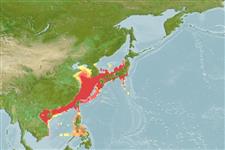Élasmobranches (requins et raies) (sharks and rays) >
Carcharhiniformes (Ground sharks) >
Triakidae (Houndsharks) > Triakinae
Etymology: Mustelus: Latin for weasel, an ancient name for sharks, possibly referring to the pointed snouts, swift movements and/or rapacious feeding behavior of smaller predatory sharks [strictly not tautonymous with Squalus mustelus Linnaeus 1758 since type was designated by the ICZN]. (See ETYFish); griseus: Medieval Latin for gray, referring to gray or gray-brown color. (See ETYFish).
Environment: milieu / climate zone / depth range / distribution range
Écologie
marin démersal; profondeur 5 - 300 m (Ref. 104830), usually 51 - ? m (Ref. 104830). Tropical; 41°N - 11°N, 105°E - 142°E
Northwest Pacific: Japan, Korea, China, Taiwan, and Viet Nam (Ref. 244). Possibly occurring in the Philippines (Ref. 13563).
Length at first maturity / Taille / Poids / Âge
Maturity: Lm 72.0, range 70 - 74 cm
Max length : 87.0 cm TL mâle / non sexé; (Ref. 244); 101.0 cm TL (female); âge max. reporté: 9 années (Ref. 6983)
An inshore bottom-dwelling shark found down to at least 51 m (Ref. 244); also dwells in semi-enclosed sea areas with sand bottom (Ref. 11230). Probably feeds on benthic invertebrates, especially crustaceans (Ref. 13563). Viviparous, with a yolk-sac placenta (Ref. 244).
Viviparous with a yolk-sac placenta. Produces 5 to 16 young per litter, with larger adults having larger litters of young. Gestation period is 10 months, birth occurring in April and May. Size at birth about 28 cm (Ref. 244).
Compagno, L.J.V., 1984. FAO Species Catalogue. Vol. 4. Sharks of the world. An annotated and illustrated catalogue of shark species known to date. Part 2 - Carcharhiniformes. FAO Fish. Synop. 125(4/2):251-655. Rome: FAO. (Ref. 244)
Statut dans la liste rouge de l'IUCN (Ref. 130435)
Utilisations par l'homme
Pêcheries: commercial
Outils
Articles particuliers
Télécharger en XML
Sources Internet
Estimates based on models
Preferred temperature (Ref.
123201): 11.1 - 23.2, mean 18.5 °C (based on 212 cells).
Phylogenetic diversity index (Ref.
82804): PD
50 = 0.5000 [Uniqueness, from 0.5 = low to 2.0 = high].
Bayesian length-weight: a=0.00224 (0.00105 - 0.00478), b=3.14 (2.97 - 3.31), in cm total length, based on LWR estimates for this Genus-body shape (Ref.
93245).
Niveau trophique (Ref.
69278): 3.5 ±0.4 se; based on diet studies.
Generation time: 5.5 ( na - na) years. Estimated as median ln(3)/K based on 1
growth studies.
Résilience (Ref.
120179): Très faible, temps minimum de doublement de population supérieur à 14 ans (tm=5.3-6.5; tmax=9; Fec=5).
Fishing Vulnerability (Ref.
59153): High vulnerability (59 of 100).
Nutrients (Ref.
124155): Calcium = 28.8 [8.9, 143.9] mg/100g; Iron = 0.482 [0.142, 1.730] mg/100g; Protein = 20.7 [18.3, 23.0] %; Omega3 = 0.0918 [, ] g/100g; Selenium = 85.5 [25.8, 320.1] μg/100g; VitaminA = 15.1 [5.3, 42.3] μg/100g; Zinc = 1.07 [0.47, 2.18] mg/100g (wet weight);
